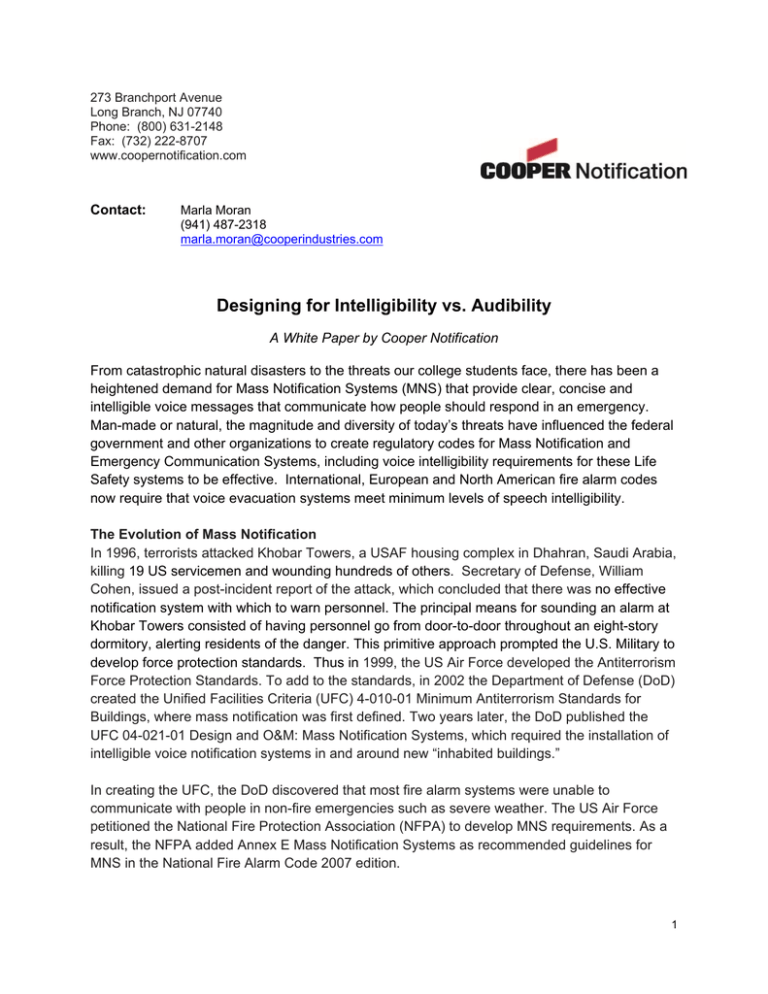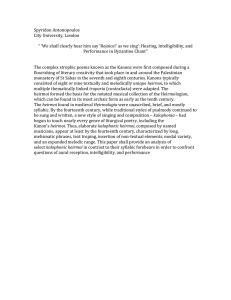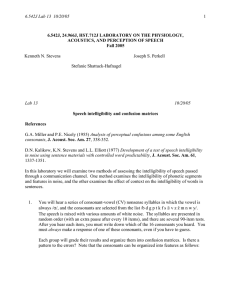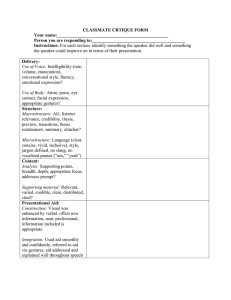White Paper - BgB Supply
advertisement

273 Branchport Avenue Long Branch, NJ 07740 Phone: (800) 631-2148 Fax: (732) 222-8707 www.coopernotification.com Contact: Marla Moran (941) 487-2318 marla.moran@cooperindustries.com Designing for Intelligibility vs. Audibility A White Paper by Cooper Notification From catastrophic natural disasters to the threats our college students face, there has been a heightened demand for Mass Notification Systems (MNS) that provide clear, concise and intelligible voice messages that communicate how people should respond in an emergency. Man-made or natural, the magnitude and diversity of today’s threats have influenced the federal government and other organizations to create regulatory codes for Mass Notification and Emergency Communication Systems, including voice intelligibility requirements for these Life Safety systems to be effective. International, European and North American fire alarm codes now require that voice evacuation systems meet minimum levels of speech intelligibility. The Evolution of Mass Notification In 1996, terrorists attacked Khobar Towers, a USAF housing complex in Dhahran, Saudi Arabia, killing 19 US servicemen and wounding hundreds of others. Secretary of Defense, William Cohen, issued a post-incident report of the attack, which concluded that there was no effective notification system with which to warn personnel. The principal means for sounding an alarm at Khobar Towers consisted of having personnel go from door-to-door throughout an eight-story dormitory, alerting residents of the danger. This primitive approach prompted the U.S. Military to develop force protection standards. Thus in 1999, the US Air Force developed the Antiterrorism Force Protection Standards. To add to the standards, in 2002 the Department of Defense (DoD) created the Unified Facilities Criteria (UFC) 4-010-01 Minimum Antiterrorism Standards for Buildings, where mass notification was first defined. Two years later, the DoD published the UFC 04-021-01 Design and O&M: Mass Notification Systems, which required the installation of intelligible voice notification systems in and around new “inhabited buildings.” In creating the UFC, the DoD discovered that most fire alarm systems were unable to communicate with people in non-fire emergencies such as severe weather. The US Air Force petitioned the National Fire Protection Association (NFPA) to develop MNS requirements. As a result, the NFPA added Annex E Mass Notification Systems as recommended guidelines for MNS in the National Fire Alarm Code 2007 edition. 1 In the NFPA 72 National Fire Alarm and Signaling Code 2010 edition, Annex E became Chapter 24 Emergency Communications Systems (ECS), the first mass notification code for the private sector. Most recently Underwriters Laboratories (UL) established a new standard for mass notification as well – UL 2572. It measures how a Mass Notification System (MNS) performs against the NFPA ECS codes and will be identified in the NFPA 72 2013 Codes. Prior to the focus on MNS, the 1999 edition of the NFPA 72 included the first definition of voice intelligibility and added the requirement that emergency communication systems must have messages with voice intelligibility. However, most of the information was placed in the Annex as guidelines with references to IEC standards for quantitative measurement approaches. In the 2007 Edition, intelligibility was referenced in more locations, and when Annex E on MNS was added, it generated renewed focus on Intelligibility. In NFPA 72 2010, the requirement for intelligibility was moved into Chapter 24, Code, no longer a guideline. It also included Annex D Speech Intelligibility and Supplement 2 Emergency Communications Systems Design and Application challenges and Supplement 3 Voice Intelligibility for Emergency Voice/Alarm Communication Systems. There’s no doubt in the 2010 edition that intelligibility is key to the design of an ECS. In NFPA 72 2013, Chapter 14 clarified intelligibility testing requirements. Previous codes specified that where voice intelligibility was required, intelligibility was required to be verified via test methods identified in ANSI S3.2, IEC 60849, or other methods acceptable to the AHJ. The 2013 codes state that voice communications using prerecorded and manual voice announcements must be verified as being distinguishable and understandable. A simple listen test, a qualitative assessment, is permitted by code. If you can understand the message being delivered, it would meet the intelligibility requirements. Quantitative testing measurements for intelligibility are not required by code. For many designers and system integrators, speech intelligibility is a relatively new subject. Fortunately, the field of speech intelligibility is not new to other industries such as commercial sound. Much of the research on speech intelligibility metrics was born out of the widespread acceptance of the telephone and the use of telephones and radios for military communications in the early part of the 20th Century. For the telephone, the needs of the consumer drove the level of quality necessary for product success. Military communications also drove the development of ways to measure or predict speech intelligibility. Since the requirements for intelligibility are fairly new to the Fire and Life-Safety market, Cooper Notification has written this white paper to help educate system integrators and designers on the basic understanding of speech intelligibility, how it applies to MNS, NFPA code terminology, factors that affect intelligibility, tools available to help design intelligible systems and how to measure it. 2 Defining Intelligibility and Other Key Terminology NFPA’s 2010 definition of intelligibility changed slightly from NFPA 72 2007. The 2010 code defines intelligibility as “the quality or condition of being intelligible” (3.3.125) and intelligible as “capable of being understood; comprehensible; clear” (3.3.126). The 2007 edition defined voice intelligibility as “audible voice information that is distinguishable and understandable” (3.3.211). Although the definitions can be rather vague, what should be clear is the distinction between intelligibility versus audibility. Both are critical to providing proper instructions in an emergency to building occupants, but the terms are not the same. Think of the sayings, “Loud and Clear” and “I have you 5 x 5,” which is military jargon for subjective loudness and clarity measurements. 5x1 is loud but not clear, and 1x5 is not loud but crystal clear. Audibility, usually measured in decibels (dB, dBA) is the state or quality of being perceptible by the human ear. Normal calculations for Fire Alarm professionals for audibility are fairly straightforward – 15 dBA over ambient, doubling the distance from the source and lose 6 dB, for example 100 dB at 10’, 94 dB at 20’, 88 dB at 40’. Audibility can be measured with a Type II Sound Level Meter. Whereas, intelligibility, according to a report from the Fire Protection Research Foundation “is a measureable aspect of electronic voice transmission systems that indicates the degree that human listeners will be able to understand the voice messages transmitted through them.” Measurement is usually expressed as a percentage of a message that is understood correctly. A variety of test methods are available to measure speech intelligibility, which will be introduced later in this White Paper. A system that produces a high level of audibility does not mean that it is intelligible. Basically, if a voice message cannot be understood by building occupants, then the ECS has failed and may have caused more harm than good. Listening to an unintelligible voice message is like driving in pitch black darkness with no headlights. You have no idea where you are going. Therefore it is important to understand how to properly plan, design and measure intelligibility for each installation based on factors that affect intelligibility and which spaces require it, which leads us to the next definition. New to NFPA 72 2010 and an important term to understand when designing for intelligibility is Acoustically Distinguishable Space (ADS). Defined by NFPA, an ADS is an Emergency Communications System zone, subdivision, physically defined space or section of a room that might be distinguished from other spaces because of different acoustical, environmental or use characteristics such as ambient sound pressure level. An ADS is an area that has the same acoustic properties like multiple rooms/spaces which have the same ceiling height as well as the same walls, ceiling and floor treatments. If a room has different acoustic properties in different areas, the areas become multiple ADS. All parts of a building intended to have occupant notification are subdivided in ADS. As determined by the system designer during the planning and design phase of the ECS, each ADS must be identified as either requiring intelligibility or not requiring intelligibility. 3 According to the NFPA, an ADS that differs from another space because of frequency and level of ambient noise might require speakers and system components that have a wider frequency bandwidth such as Cooper Notification’s Wheelock Exceder LED High Fidelity speakers and speaker strobes and Series EH High Fidelity speakers and speaker strobes. Updates for 2013 include new sections that require system designers to identify and document which locations will have audible notification and which spaces will not. There were two reasons for the addition. The first reason is to show users that there may be areas where audible notification will not be provided, and the second was to set up documentation requirements. In an intelligibility report developed by the National Electrical Manufacturers Association (NEMA), the organization noted, “In Airports and meeting places, we frequently see paging systems with speakers every eight to 12 feet (three to four meters). How will the speech intelligibility of the adjacent fire alarm system compare when it has speakers spaced 40 to 70 feet (10 to 20 meters) apart?” It is important to understand how to properly plan, design and measure intelligibility for each installation based on which spaces need intelligibility and the factors that affect it. 4 Factors that affect intelligibility Speech intelligibility is multifaceted and complex. It can’t be measured physically such as feet, volts, or even decibels. Intelligibility is the degree to which we understand what is being said. NEMA states that designers have the greatest effect on speech intelligibility by their choice of equipment, the number, distribution and placement of loudspeakers and the power at which they are driven. However, designing an ADS for intelligible voice can be complicated by many variables. Signal-to-Noise Ratio Signal-to-Noise Ratio compares the sound level output from the speaker to ambient noise in the room. It is the obscuring of voice due to background noise - the higher the ratio, the greater the intelligibility. Humans can tolerate a significant amount of background noise. However, once intelligibility begins to diminish, it diminishes rapidly. In Chapter 18, NFPA recommends an average of 15 dB over ambient noise. Higher than 15 dB results in reduced returns in terms of improving intelligibility. The rule of thumb for better intelligibility is increasing the number of speakers and utilizing the lower tap settings instead of increasing the sound output on the speakers. Increasing the wattage of speaker can often distort the message. Most offices, lobbies, department stores, banks and restaurants are fairly quiet (55-70 dB) and can be predictably dealt with using ceiling or wall speakers tapped or set at 1 watt or less. This is usually more than enough power to generate sufficient volume. Noisier environments are generally industrial areas or large expansive areas such as warehouses. For best results, use a sound level meter and take SPL readings during peak noise hours so the system can be designed for “worst case” conditions. Here are some examples of the most commonly encountered commercial background noise levels: 5 Harmonic Distortion A well-spoken intelligent message can be misunderstood if it is distorted by the delivery system or distorted by the acoustic environment. Distortion is the noise that masks the original speech signal, resulting from one of the electrical or electro-acoustical components in the transmission. For example, severe clipping can make an ideal speech signal difficult to understand. The reduction of intelligibility by distortion can be caused by: Amplitude distortion from electronics/hardware Frequency distortion from electronics/hardware or the acoustic environment Time domain distortion due to reflection and reverberation in the acoustic environment A wide-range of elements affect distortion, which include loading of audio amplifiers, tolerance of the message generator and amplifier, and mechanical factors such as excessive voltage drop in the speaker line, wires touching the cone of the speaker, vibration caused by poor installation, and damaged speakers. As little as 2 percent distortion is the average amount you can detect while listening to sound output. However, when sound output reaches 15 percent distortion, it is considered unintelligible. Frequency Response Humans hear by frequency from around 50Hz up to 22kHz. However, most energy of normal speech is 500 Hz to 4 KHz. Fire Alarm and Mass Notification systems generally produce frequency responses of 400 Hz to 4 KHz. Commercial sound systems usually distribute frequency responses of 125 Hz to 12.5 KHz, and professional sound systems deliver frequency responses of 20 Hz to 20 KHz. Since we can hear from around 50Hz up to 22kHz, the wider the frequency response of a speaker, the better it is at reproducing the frequencies in the original signal. Thus the better we understand it. When a person speaks, there are many frequencies encoded in that speech. If the loudspeaker re-producing that speech can’t handle certain frequencies in that speech, you’ll lose some of the information in what was originally said. It won’t sound clear. So having a wider frequency response means that the speaker makes the speech easier to understand to whomever is listening. Fire alarm speakers designed in accordance with UL 1480 are only tested for and required to produce frequencies of 400 to 4000 Hz, the average range for human ears. Speech includes a wider range of frequencies. Speech Transmission Index (STI) and STI-Public Address (STIPA) range from 125 Hz to 8000 Hz. Under certain acoustic conditions, systems that do not produce the highs and lows can produce speech intelligibility that is less than desired. I. B. Crandall, who wrote “The Composition of Speech,” noted in 1917, "It is possible to identify most words in a given context without taking note of the vowels...the consonants are the determining factors in...articulation." Most of the average energy is in vowels, which lie below 3 kHz. However, the most critical elements of speech, are the consonants, which lie above. Since 6 consonant sounds are faster, much lower in sound level (10 – 30 dB) and occupy higher frequency bands, they are also the most difficult to hear and discern. The burst of highfrequency sound that distinguishes the "s" in "sailing" from the "f" in "failing" occurs between 4 kHz and 14 kHz. Or in an emergency, intelligible voice communications reduces the chances of Stair B being misinterpreted as Stair D, Stair C or Stair E. When these frequencies are removed, no clue remains as to which exit to take. The wider frequency response range of speakers sounds better and is more intelligible to listeners. A relatively flat frequency response is desirable because a peak or dip in response can degrade the ability to comprehend sounds. The frequency response must be consistent throughout the listening area, demanding good speaker coverage with minimal high frequency roll-off. Designers and engineers have the greatest effect on speech intelligibility by their choice of equipment, the number and distribution of loudspeakers, and the power at which they are driven. Reverberation Many are familiar with how difficult it can be to interpret speech in large, open area environments with reflective surfaces such as a gymnasium or airport. Room reverberations cause sounds to arrive at the listener at delayed times, which blur or smear speech making it less clear and thus more difficult to understand. Reverberation is made up of echoes or sound reflections after the initial sound source is removed. This is the main reason why it is can be impossible to achieve a required intelligibility score in certain environments. When echoes are spaced too closely together, the sound cannot be understood by the listener. Minimizing reverberation is key to achieving intelligibility. Numerous factors affect reverberation, including orientation of speakers, sound output of speakers, size of the room, and reflective properties of surfaces. Adding more sound level to speech that has been blurred by reverberation, echoes or distortion does not make it more intelligible. Physical Room Characteristics Room reverberation depends on the physical characteristics of the space such as room dimensions, construction materials, whether or not there are occupants in the space and furnishings. NFPA states that the amount of reverberation in a room diminishes when the room includes construction features, people, or furnishings that absorb sound. From space to space or room to room, the amount of reverberation varies. It relies on the absorption characteristics of the materials in a particular space. Soft surfaces absorb sound, and hard surfaces reflect sound rather than absorb it. To reduce reverberation, designers should locate loudspeakers away from hard surfaces, and point the speakers towards soft, absorbent surfaces. For future occupancies, designing for intelligibility must include collaboration between the system designer, the architect and the interior designer. The ECS designer should have an understanding of the acoustic characteristics of the architectural design. According to the Fire Protection Research Foundation 2008 Report, “Intelligibility of Fire Alarm and Emergency Communication Systems,” designers will need to know all room dimensions, room use, room occupancy, room finishes and treatments, and speaker polar plots. Conducting a design 7 analysis could reveal that an intelligible system is not achievable unless some features of the architectural design are changed. For example, changing room finish from carpet to ceramic tile will usually make intelligibility worse, but may make audibility better. Changing room finish from tile to shag carpeting will usually make intelligibility better, but will make audibility worse. Designers must keep up with room finish changes on projects since the amount of reverberation in a room diminishes when the room or space includes construction features, people or furnishings that absorb sound. A well-spoken intelligent message in the listener’s native language can be misunderstood if it is not audible to the listener, distorted by the delivery system, or distorted by the acoustic environment. Designing for Audibility: Prior to the 2010 Codes, most fire evacuation systems were designed to meet Codes that were adopted by the Authority Having Jurisdiction (AHJ), which usually stressed audibility rather than intelligibility. Whether it was a tone only or a voice system, the same principals were employed – 60 to 75 dB minimum depending on the mode and usually 10 to 15 dB over ambient noise levels. Intelligibility was not usually built into the design because it was not “required,” and most fire professionals were not familiar with designing and/or testing this type of system. If a design is for tone only audible notification, most designers go with the visible design requirements of ADA. In general, this means that no place in any room or space required to have a visual signal shall be more than 50 feet from the signal. When discussing audibility, there are two important terms - Sound Pressure Level (SPL), the loudness or volume and decibels (dB), which is how SPL is expressed. When talking in dBs, you are referencing the difference between two sound levels. For example, 100 dB SPL means 8 a sound pressure level 100 dB above a zero point set at the lowest sound pressure level discernible by the average human ear. A 3 dB difference can be heard by most people. It takes approximately a 10 dB difference in average SPL to be perceived as doubling loudness. Doubling the amplifier power gives only a 3 dB increase in a speaker’s output. The same result or better can be obtained by using a more efficient speaker. For example, a ceiling speaker might specify 92 dB SPL at 1 meter distance from the speaker with 1 watt of applied power. Yet, a different speaker may yield 95 dB SPL at 1 meter at 1 watt. That’s 3 “free” dB or about 30% more volume because of the difference in speaker efficiency. A speaker’s loudness (SPL) is affected by two laws of physics: The power (in watts) applied to the speaker and the distance between the listener and the speaker itself. As previously stated, if you double the power to a speaker, you gain 3 dB. If you cut the power in half, you lose 3 dB. For example, if you have an appliance that produces 90 dB at a distance of 64 feet using the 1 watt tap, then doubling the power by using the 2 watt tap will give you 93 dB. A modest gain at best, and something to really consider since doubling the power can mean double the amplifier cost. A more efficient speaker or more effective placement can give you that extra 3 dB without having to double the amplifier power. For ceiling mount installation in most offices, stores, schools, etc., recessed ceiling mount speakers can be used. Space the speakers at twice the ceiling height. If the ceiling is 12 feet high, space the speakers 24 feet apart. With the introduction of intelligibility, designing for audibility is still important as the requirement to maintain 15dB above the ambient noise is part of the Codes. The installer should design for and then measure the installation for proper sound pressures. Every time the distance from the speaker is doubled the sound pressure drops 6 dB, cut the distance in half, and you gain 6 dB. The designer must plan for this and space the speakers accordingly. This will cause the design to plan for edge-to-edge spacing and measurements taken at the fifth level. The result is that there will be a 6 dB difference in audible SPL as a person walks from speaker to speaker. For audibility requirements, this will pass the inspection but for intelligible sound qualities it will not. Designing for Intelligibility As mentioned earlier, each ADS shall be identified as requiring intelligibility or not requiring intelligibility. In general, intelligibility is usually required in occupiable spaces, similar to audibility. The engineer or designer has to make the determination as to whether intelligibility is required or achievable in the ADS and if so, how to achieve it. NFPA exempts areas like mechanical rooms, elevator rooms, individual offices and private bathrooms. If the AHJ requires intelligibility, ADS assignments must be submitted for review and approval. In order to be effectively heard, an ECS has to be loud enough to be heard above the noise level of the environment, and intelligible, which means the system should produce clear, voice messages that are understood by the listener. An important point to remember is that effective 9 coverage in a room depends more upon speaker placement, the type of speaker and spacing than upon volume of the speaker themselves. For example, a garden hose has a certain spray pattern. Increasing the water pressure will not give you greater coverage for your garden but adding another nozzle certainly will. In a similar fashion, multiple speakers “spray” sound evenly to all areas and create a uniform sound field. Achieving sufficient intelligibility is not simply a matter of turning up the volume or increasing the wattage of the speaker. Many poor evacuation systems are the result of trying to compensate for an insufficient amount of speakers with too much volume. At one end of the room people are asking “What did he say?” while the people near the speaker are blasted with noise. The general rule of thumb is that a lot more speakers at lower wattage taps are required for designing for intelligibility. It can be as much as eight times as many speakers used to achieve audibility alone, and increasing the wattage can often distort the message. The deal pointsource (speaker to listener) is 20’ or less. Ceiling height is speaker spacing. This is not a typo. For example, if the ceiling is 12 feet high, space the speakers 12 feet apart for intelligibility versus 24 feet apart for audibility. Acoustic performance parameters of chosen loudspeakers and placement are key to determining how many appliances are necessary for adequate intelligibility. The numerical count of appliances for a given design and protected space cannot by itself be used to determine the adequacy of design. Sometimes the acoustic problems of certain placement constraints can be overcome through careful selection of loudspeakers with the requisite performance characteristics, rather than by increasing their number. Not all areas can achieve intelligibility. Think of historic buildings, polished marble floors and walls, hard plaster ceiling, no carpeting, and no baffling. In some spaces, like machinery and high-ambient SPL areas, it might be impractical to achieve intelligibility. Reasonable approach for such areas may be rally points where intelligibility can be obtained - people hear audible signal and have to go to a place to comprehend an intelligible signal. Referring to NFPA 72 2013 “National Fire Alarm and Signaling Code Handbook,” consulting a sound professional and utilizing commercially available software tools are recommended when designing spaces and rooms for voice intelligibility. EASE Evac is an example of a sound modeling program that simplifies audio design with tools to define the space finishes so a true design can be developed for intelligibility. Designing for Outdoor Areas The same principals also pertain to designing intelligible systems for outdoor areas. However, there are additional parameters to consider such as wind, temperature, humidity, changing of the environment due to seasons, age, and time. For example, vegetation growth affects sound. Designing a Wide-Area MNS in the middle of winter when trees are bare without considering trees in full bloom can greatly affect the intelligibility of the system. 10 Software Design Tools Based on the proven EASE professional sound design technology, EASE Evac was developed specifically for life safety professionals. It will assist in the design of MNS to meet new intelligibility code requirements and save designers and installer’s time and money by limiting over-design and reducing post-installation changes. In EASE Evac, all rooms are defined by a 2D floor plan and a height, including outdoor space. This simple approach speeds up modeling tremendously in everyday projects. The import of images, AutoCAD DXF-format or Google SketchUp files as well as EASE room models simplifies the building of rooms with a complex layout. Several tools enable a quick modeling from scratch. Projects can consist of more than one room, each with its own room acoustic, defined by entering the reverberation time or assigning wall materials with their absorption coefficient to the surfaces of the room. The 3D simulation software calculates the distribution of direct sound levels as well as total sound levels, the signal-to-noise ratio (SNR) and speech intelligibility testing (STI, CIS). The latter calculations are based on statistical room acoustics. Intelligibility Testing The measurement (modeling) of speech intelligibility has been extensively studied, developed and standardized outside of the fire alarm industry. The ability to understand speech distributed by a loudspeaker can be measured or graded. In the 2010 edition of NFPA 72, Annex D, Voice Intelligibility was added on recommendations for testing of the intelligibility of voice systems – When, where and how to test for speech intelligibility. Supplement 3 also includes information on intelligibility testing methods. There are two basic categories of intelligibility testing: 1) Subject (human) based testing – ANSI S3.2 2) Electronic based test methods – ANSI S3.5 With human-based testing, subjects listen to the specifically constructed speech samples distributed over loudspeakers and report sentences and the words that they hear. Statistical results are accumulated to assess how much was heard by the subjects. According to NFPA, test methods that use human subjects are only statistical predictions of how well speech might be understood at any other time for any other group of listeners. These tests are usually described as predictions, not measurements. Most users of the electronic-based testing refer to the results as measurements, not predictions. While considered the most accurate, subject-based testing is impractical for most spaces, time consuming and expensive. Several subject based test methods have been extensively researched, tested for reliability and standardized. Examples include the Phonetically Balanced (PB) word scores (256 words or 11 1000 words) and Modified Rhyme Test (MRT). However, quantitative based methods are arguably less subjective, more repeatable, and easier to implement. Several instrument-based methods for predicting speech intelligibility have been extensively researched and tested for accuracy and repeatability, and the methods have been standardized. Instrument-based testing includes sound energy, analyzing reverberation and signal-to-noise ratio of the room. Since reverberation and signal-to-noise ratio effects on speech intelligibility are widely understood, electronic testing can produce results that closely align with subjectbased testing. Most recognized are the following quantitative based methods: Articulation Index (AI), now referred to as Speech Intelligibility Index (SII) Speech Transmission Index (STI) and Speech Transmission Index for Public Address (STIPA), a modified method of STI SII is calculated from acoustical measurements of speech and noise. It is computed as a physical measure that is highly correlated with the intelligibility of speech as evaluated by speech perception tests given to a group of talkers and listeners. STI, a well-known objective test method, predicts how the characteristics of the transmission channel affect speech intelligibility. It is a numeric representation measure of communication channel characteristics whose value varies from 0 = bad to 1 = excellent. Common to the ECS industry is STIPA, a simplified version of STI designed for practical application in specific situations. Each of the recognized speech intelligibility methods has a finite measurement scale. To equate the values from each scale, the Common Intelligibility Scale (CIS) was developed to show the relationship between the different methods. The purpose in developing CIS was to allow codes and standards to require a certain level of performance while permitting any of the accepted measurement methods to be utilized. NFPA states that intelligibility of an emergency communication system is considered acceptable if at least 90 percent of the measurement locations within each ADS have a measured STI of not less than 0.45 (0.65 CIS) and an average STI of not less than 0.5 STI (0.70 CIS). Best case testing of many Mass Notification and Fire Alarm systems with no appreciable wiring and near perfect acoustics in the aural field is 0.75 STIPA (0.5 passing) or 0.85 CIS (0.7 12 passing). This means that acoustics and speaker performance must be evaluated carefully before installing a system. As mentioned previously, NFPA 72 2013 does not require quantitative test measurements. Only ADS that require voice intelligibility need to be verified as distinguishable and understandable. A simple listen test, a qualitative assessment, is permitted by code. Designers, owners and AHJ decide when and where testing is required. In the UFC, DoD facilities are required to verify intelligibility by measurement after installation. However, there are separate voice intelligibility requirements for the different branches of service. The U.S Army and Air Force require a minimum CIS score of 0.80, although rounding is permitted such that a value of 0.75 may be rounded to 0.8. The U.S. Navy and Marine Corps require a minimum CIS score of 0.7. In the latest UFC, testing for exterior, Wide-area MNS will be required. Designing for intelligibility takes practice. Before testing, system designers should make sure: ECS design is for completed and occupied spaces unless specifically directed to do otherwise Audibility is achieved Audio system is balanced Amps are calibrated Unity gain Control room is quiet; Radios, talking, door slams, etc. will mess up testing Construction is complete Measured in Common Intelligibility Scale (CIS), 0.7 or higher usually passing or Sound Transmission Index Public Address (STIPA), 0.5 or higher usually passing In summary, make sure you know what you are measuring. Intelligibility is a whole new animal, and designing for it can be complicated since many factors such as ambient noise, reverberation, distortion, frequency response, and physical room characteristic affect how much of the message is understood. Designers have the greatest effect on speech intelligibility by their choice of equipment, the number, distribution and placement of loudspeakers and the power at which they are driven. Designing for intelligibility requires a lot of knowledge about sound. Consulting a sound professional and utilizing a computer modeling tool are recommended when designing spaces and rooms for voice intelligibility. Cooper Notification is a unit of Cooper Safety, part of the electrical business of Eaton. Eaton acquired Cooper Industries plc in late 2012. Cooper Notification is a leading source for notification solutions supporting fire, security, hazardous area, mass notification, voice evacuation and industrial signaling applications. For more information, visit the web site at www.coopernotification.com. For information about Eaton, visit www.eaton.com. 13 References NFPA 72 “National Fire Alarm and Signaling Code Handbook,” Quincy MA, 2010 Edition. NFPA 72 “National Fire Alarm and Signaling Code Handbook,” Quincy MA, 2013 Edition. B. Crandall, “The Composition of Speech,” Phys. Rev. 10 ser. 2 (1917): 75. Schifiliti, R.P., “Speech Intelligibility”, NEMA Supplement, Fire Protection Engineering, Society of Fire Protection Engineers, Issue No. 16, Fall 2002. Geoffroy, N.A., “Measuring Speech Intelligibility in Voice Alarm Communication Systems”, Master’s Thesis, Worcester Polytechnic Institute, 5 May 2008. Jacob, K.D. & Tyson, T., “Computer-Based Prediction of Speech Intelligibility for Mass Notification Systems”, SUPDET 2008, Fire Protection Research Foundation, Mar 2008. Jacob, K.D., “Understanding Speech Intelligibility and the Fire Alarm Code”, presentation at NFPA WSCE, Anaheim CA, 14 May 2001. Casey Grant, “Intelligibility of Fire Alarm and Emergency Communication Systems” Fire Protection Research Foundation, Nov. 2008. 14




